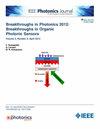低信噪比镜面反射ris辅助VLCP系统的设计与优化
IF 2.4
4区 工程技术
Q3 ENGINEERING, ELECTRICAL & ELECTRONIC
引用次数: 0
摘要
本文研究了在低信噪比条件下,利用镜面反射可重构智能面(RIS)优化集成可见光通信与定位(VLCP)系统的性能。具体而言,我们将低信噪比渐近容量作为通信指标的标准,而将crmer - rao下界(CRLB)作为定位性能指标。讨论了VLCP系统在低信噪比下的性能,因为如果接收器遇到大量噪声干扰(如走廊等低照度条件)或发射器对强度施加限制性限制(如生物暗室实验室),则可能发生这种情况。推导了低信噪比下RIS辅助多led VLCP系统的CRLB和渐近容量,并分析了RIS参数与通信或定位性能的关系。在满足CRLB和RIS参数约束的情况下,以容量最大化为优化目标,建立了两个优化问题。为了解决非凸优化问题,我们利用凸松弛、函数的单调性、半定松弛(SDR)和贪婪算法。在此基础上,提出了综合两阶段贪心算法和基于贪心策略的凸松弛算法来确定RIS的最优配置。仿真结果表明,在低信噪比条件下,RIS的应用可以明显提高VLCP系统的性能,同时,所提出的算法是解决系统性能优化问题的有效方法。本文章由计算机程序翻译,如有差异,请以英文原文为准。
Design and Optimization of Specular Reflecting RIS-Aided VLCP System With Low SNR
This paper investigates the optimization of the integrated visible light communication and positioning (VLCP) system performance with the aid of specular reflecting reconfigurable intelligent surface (RIS) when the received signal is subject to low signal-to-noise ration (SNR). Specifically, we focus on the low SNR asymptotic capacity as the criterion of communication indicator whereas the Cramer-Rao low bound (CRLB) as the positioning performance indicator. The VLCP system performance in low SNR is discussed since the scenario may occur if the receiver encounters substantial noise interference (low illumination conditions such as corridors) or the transmitter imposes restrictive limitations on the intensity (such as biology darkroom lab). We derive the CRLB and asymptotic capacity of the RIS-aided multi-LED VLCP system in low SNR and dig out the relationship between the communication or positioning performance and the parameters of RIS. Two optimization problems are formulated with the maximization of the capacity as the optimization object while satisfying the constraints on the CRLB and RIS parameters. To address the non-convex optimization problems, we leverage convex relaxation, the monotonicity of the function, semidefinite relaxation (SDR), and greedy algorithms. Based on these techniques, we propose the integrated two-stage greedy algorithm and greedy strategy-based convex relaxation algorithm to determine the optimal configuration of RIS. From the simulation results, we show that the application of RIS can enhance the VLCP system performance in low SNR obviously, and meanwhile, the proposed algorithms are effective methods for the proposed system performance optimization problems.
求助全文
通过发布文献求助,成功后即可免费获取论文全文。
去求助
来源期刊

IEEE Photonics Journal
ENGINEERING, ELECTRICAL & ELECTRONIC-OPTICS
CiteScore
4.50
自引率
8.30%
发文量
489
审稿时长
1.4 months
期刊介绍:
Breakthroughs in the generation of light and in its control and utilization have given rise to the field of Photonics, a rapidly expanding area of science and technology with major technological and economic impact. Photonics integrates quantum electronics and optics to accelerate progress in the generation of novel photon sources and in their utilization in emerging applications at the micro and nano scales spanning from the far-infrared/THz to the x-ray region of the electromagnetic spectrum. IEEE Photonics Journal is an online-only journal dedicated to the rapid disclosure of top-quality peer-reviewed research at the forefront of all areas of photonics. Contributions addressing issues ranging from fundamental understanding to emerging technologies and applications are within the scope of the Journal. The Journal includes topics in: Photon sources from far infrared to X-rays, Photonics materials and engineered photonic structures, Integrated optics and optoelectronic, Ultrafast, attosecond, high field and short wavelength photonics, Biophotonics, including DNA photonics, Nanophotonics, Magnetophotonics, Fundamentals of light propagation and interaction; nonlinear effects, Optical data storage, Fiber optics and optical communications devices, systems, and technologies, Micro Opto Electro Mechanical Systems (MOEMS), Microwave photonics, Optical Sensors.
 求助内容:
求助内容: 应助结果提醒方式:
应助结果提醒方式:


